By Darren Griffin
GPS Photo loggers which allow you to add geotag information to your pictures are the current 'must have' gadget, indeed we have reviewed a fair few already. ATP's Photofinder however, approaches this market segment from a new angle.
Whereas the majority of solutions to date have required dedicated software that links the data gathered by the photo logger to the photographs taken, ATP's unit has an SD card slot into which you insert a memory card containing photographs. the unit then writes the location data it has logged into the EXIF data for each photograph.
This is very much simpler and is software independent. It has been our experience when reviewing photo loggers in the past that the core differentiator has been the quality of the software supplied, however even the better solutions are far from perfect. ATP's novel approach means you can use commercial photo packages that are EXIF aware and that can read location data, a much better option in my opinion. The unit also has full data logger functionality with sufficient memory to store 550 hours worth of log data (5 sec intervals).
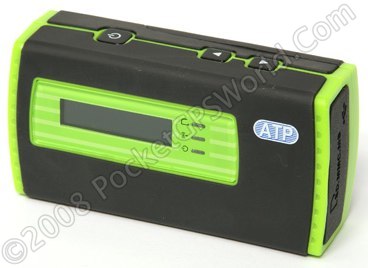 The Photofinder The Photofinder
The unit itself is larger than the majority of basic photo loggers but not overly so. Our review unit came in a lurid lime green/black colour combination, not one you could easily misplace!
Externally the only buttons are Power On/Off, Up/Down for interaction with the menu, a mini-USB socket and the SD/MMC card slot.
Power is supplied courtesy of 2 x AAA batteries which resolves any issues should you run out of power in the field and there is a lanyard slot for carrying together with a plastic karabiner type clip.
Although the memory card slot is SD/MMC, you can also utilise other card formats such as Compact Flash or Sony Memory Stick using a card reader (not supplied) and the bundled mini-USB to USB cable.
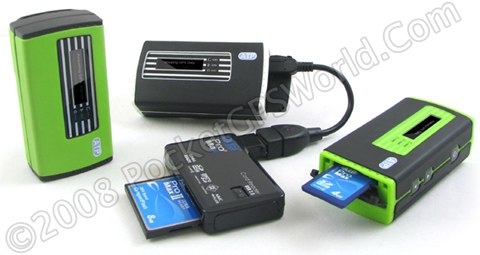
The card reader shown is not supplied
Specification
| Display |
128 x 32 Dot Matrix FSTN with back light |
| Compatible Cards |
Compact Flash
SD 2.0 SDHC
MMC 4.2
Memory Stick PRO/Duo |
| Interface |
Mini USB |
| Memory |
128Mb |
| Battery |
2 x AAA |
| USB Cable |
Mini USB to Type A Female |
| Dimensions |
82mm x 43mm x 26mm |
| Weight |
60g without batteries |
| GPS Chipset |
SiRFStarIII |
In Use
Rarely are devices as simple to operate as they claim but this one really is very straightforward. Insert batteries, switch on and obtain a satellite fix.
Once a fix has been acquired the UTC time is displayed on the LCD display. All that remains to do is to ensure the clock on your camera is set to the same time.
You can then clip the Photofinder to your belt or some other convenient location and proceed as normal taking your photographs.
At the end of the day/session, remove the memory card from your camera and insert into the slot on the Photofinder. A simple dialogue on the LCD display indicates how many photos have been located and asks for confirmation before writing the data.
The Photofinder also has the ability to create a Google Earth format .kml file which can also be saved to the memory card if desired at this stage.
5 Easy Steps
 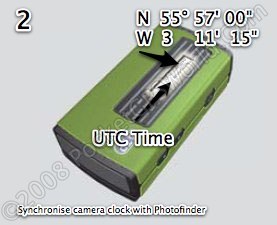
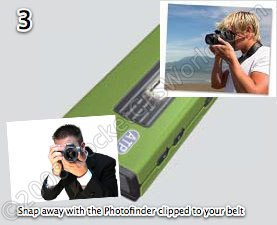 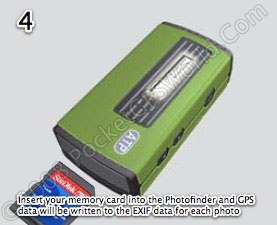
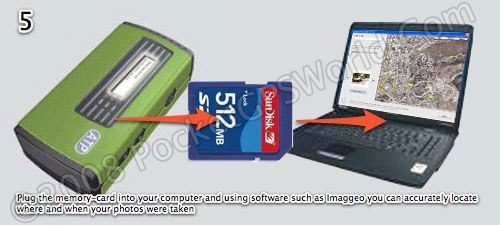
During testing we were able to eke out about 7hrs of continuous usage from a fresh set of Duracell Alkaline batteries.
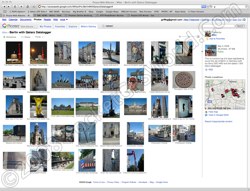 The Photofinder integrates with any package that is GPS/Geotag aware and there is a long list of well known and respected solutions including Picasaweb from Google and Immageo. The Photofinder integrates with any package that is GPS/Geotag aware and there is a long list of well known and respected solutions including Picasaweb from Google and Immageo.
Picasa is a free download (see here) and provides image organisation, edit facilities and sharing options via its online albums as well as Geotag features and Google map/Google Earth integration.
Easydevices.co.uk are currently offering a free copy of Immageo pro with every purchase. Immageo is not only a superbly implemented photo 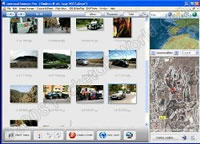 album package that allows you to store and archive your image collections but it also allows you to browse them via thumbnails and search via keywords, EXIF tags etc. album package that allows you to store and archive your image collections but it also allows you to browse them via thumbnails and search via keywords, EXIF tags etc.
Most importantly in this instance, Immageo has full GPS support for geotagged images.
Every image you take that has the location data embedded into it can be viewed from within Immageo on a Google Earth map. Even images that do not contain location data can be updated by manually locating the location of the photo on the map. Once done, Immageo will add the geotag data to the image file.
Pricing
The ATP Photofinder is available in the UK from Easydevices and at time of review was £76.00 inc of VAT. Our thanks to everyone at Easydevices for the loan unit.
 Conclusion Conclusion
ATP's Photofinder is superbly simple to use and worked quite well. I did experience some issues with poor satellite lock when I had the device attached to my belt and so it may be preferable to ensure it is carried in a manner that allows a good view of the sky but this is an issue that is not unique to this unit.
I also found the reverse white on black LCD screen difficult to read, particularly in bright sunlight and so it was sometimes difficult to confirm that a position fix had been achieved.
However, it's support for a wide range of the more common card formats (and further support for many others including the smaller formats such as mini-SD via adapters) makes it a versatile tool and earns it a PocketGPS thumbs up.
Review unit supplied by

|